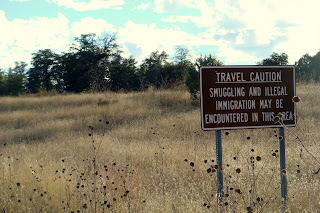 |
| Gila Wilderness |

One of the places to visit near Deming NM is the Gila Cliff Dwelling National Monument. It is one of the prettiest places I’ve been.
Scout and I arrived about the middle of the afternoon and found the visitor center parking lot nearly empty. Rather than spend time looking inside, we went directly to the cliff dwelling trailhead. One of the volunteers gave a brief ‘be careful and don’t take anything’ message and I was on my way.
Because of the fore thinking of Aldo Leopold, the Gila River and much of the surrounding land is protected. The cliff dwellings themselves are in the Gila National Forest and on the edge of a wilderness area protecting, among other things, the Gila River headwaters.
The day I visited was sunny and warm with little wind. The trail itself is slightly over a mile and set up as a loop. I meandered along smelling fall leaves that reminded me of Minnesota. I guess that’s not surprising since there are oak mixed with pine, ponderosa pine, growing in the shady side of the canyon. Both sheer and eroded rock faces marked one side of the trail and what would be a stream in the rainy season marked the other. I was told the head of the stream is a natural spring so the people of the cliff dwelling would always have water. During dry times, the spring water doesn’t make if far down the canyon before it disappears.
As I poke along looking at fall flowers, lichen and patterns on tree trunks, I come to a photo-op sign. At this point I can see across the canyon and behold a very nice wall at the front of one cave. There is a row of holes along the top marking where roof beams once rested. Vandalism started nearly as soon as the dwellings were discovered so there are no roofs nor many roof beams.
The trail crosses the canyon to the sunny side and I climb up a series of steps. Now I’m passing by cactus and I see little soil. What I do see is the baked earth look I’ve come to associate with New Mexico. I approach the first cave. It has the remains of a wall or two, a fire pit and some stone circles recessed into the ground that ‘they’ think held food or water pots.
I pass another small mostly empty cave and climb more steps into a large, long cave. The temperature drops by several degrees and the acoustics are such I can hear my breathing sort of echo. There aren’t any walls in here though the ceiling is blackened probably from smoke. And the sand that covers the floor has been raked clear of footprints.
I find volunteer rangers next. I had tried to imagine discovering and then moving to this cave as I walked to it. The guy I talked to said there was a pueblo a mile or so downstream for 700 years so those people would have known of the cave and they never used it. Then for some reason a group of people moved into it, build 40 or so rooms and only stayed one generation. Because of the rains and how they scour the land, there is no trash heap at the base of the cliff and archeologists have found nothing downstream.
Pottery fragments tell they are probably Mimbres from the north. Tree ring dating from the wood that remains say they build around 1280. There are food scraps that indicate they used all the types of native foodstuff available in the area and also grew corn, beans and squash.
On the trail back I continued to speculate on the inhabitants. All sorts of stories flitted through my mind. Were there old people or lame people? They must have used an easier route than the one laid out by the park service. It may have been a place of ceremony however they didn’t fast while they were there. Lots of speculation and no answers later I arrived at my starting place to find the gate closed. I had whiled away close to three hours walking a bit over a mile and looking at seven caves! It’s a good thing Scout and I planned on spending the night.
In the morning I walked to a second site where there is one very small cave close to the ground. There are only two rooms here with a small rainy season stream close by and the Gila River not far. Whoever used it, I found it easy to build my own picture. I like the idea of a holy man living in it. I know Anglo-European culture doesn’t allow for holy men living in caves however other cultures do and to me it fits the area and the little I have learned of these ancient people.
Leaving was hard. Sometimes I almost hear sounds that aren’t and feel the passing of something that isn’t. Am I suffering from too much imagination? I don’t know, except leaving was hard.
 |
| Gila River |






